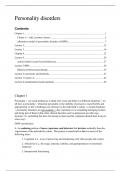Summary
Summary Personality Disorders - Grade 7.5
- Course
- Institution
This is a summary for the course Personality Disorders. I mainly used information from the slides and lectures themselves rather than the book. I received a 7.5 in this course by studying with this summary
[Show more]



